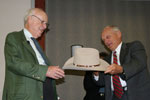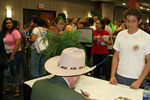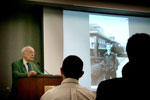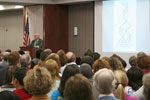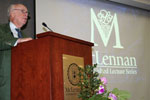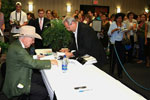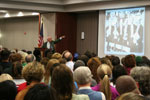James Watson - 2005

Nobel Prize winner and co-discoverer of the DNA structure
September 21, 2005
Dr. Watson recounted his dramatic 1953 discovery of the double-helix structure of DNA and the resulting implications the discovery has had on modern medicine, genetics and forensics.
Biography
Winner of the 1962 Nobel Prize for Physiology and Medicine, Dr. James Watson and his scientific partner Dr. Francis Crick uncovered the double-helix structure of DNA, discovering the basic scientific structures of life and how the organization of these proteins and nucleotides arrange themselves to create the unique identities of each living organism. TIME Magazine named Watson "One of the 100 Most Influential People of the 20th Century."
From 1988 to 1992, Dr. Watson served as head of the Human Genome Project for the National Institute of Health, which brought together thousands of scientists worldwide to crack the human genetic code. Their discoveries have broad applications in such diverse areas as forensic criminology, the study of genetics’ influence on disease development and the discovery of new treatments. Watson is the world's foremost authority on the current direction and debates surrounding genetic engineering, cloning and the future of life itself.
Watson was born in 1928 in Chicago. After graduating from the University of Chicago, he pursued the study of genetics at Indiana University, receiving a Ph.D. in 1950 at the age of 22. Since 1968, as director of the Cold Spring Harbor Laboratory in Long Island, NY, his research has centered on bacterial viruses, molecular genetics, and the synthesis of proteins.



